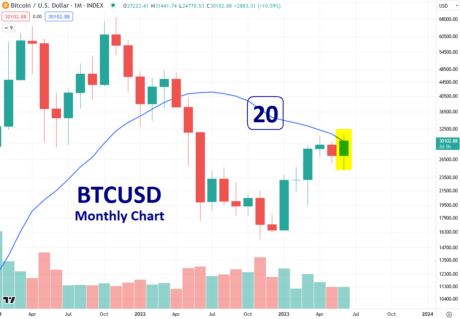Spurred on by the recent flood of spot Bitcoin ETF applications from the likes of Blackrock and Fidelity, Bitcoin impressively jumped up to the $30,000 area where momentum has stalled in recent sessions. While many analysts and traders routinely recognize the importance of the $30,000 level as a key area of resistance, Bitcoin’s move above its 20-month simple moving average (20-month SMA) may deserve a lot more attention than it gets. With Bitcoin poised for a potential big buy signal from July 1, let’s take a closer look at this undervalued signal.
The simple line that separates the Bull and Bear phases
Bitcoin’s 20-month SMA currently stands at $29,910 according to the Bitcoin/US Dollar All Time History Index, slightly below Bitcoin’s current price of just over $30,000. This puts the number one cryptocurrency by market capitalization barely above its 20-month SMA for the first time since March 2022. What is the potential meaning? If Bitcoin can close out the month of June with a monthly candle closing above the 20-month SMA, it will be only the fifth time this has happened in Bitcoin’s entire history, and a signal that has often seen higher prices follow suit.

Monthly Bitcoin Chart with SMA for 20 Months | BTCUSD at TradingView.com
For a clearer picture of the meaning of the 20-month SMA, let’s look at all of Bitcoin’s monthly closes above the 20-month SMA and below the 20-month SMA. To do this, we will create a hypothetical trading system, strictly for analytical purposes, “buy” when Bitcoin closes above its 20-month SMA and “sell” when Bitcoin closes back below its 20-month SMA. Note that “LE” indicates a buy signal, while “LX” indicates a sell signal. The blue highlight shows the periods when the system’s logic sold Bitcoin after a long exit signal and was out of the market.

Monthly Bitcoin Chart with SMA for 20 Months | BTCUSD at TradingView.com
What stands out in this chart is that the 20-month SMA almost perfectly divides the bull phases from the bear phases for most of Bitcoin’s history, from the end of 2011 to the present. For example, if you get out once Bitcoin closes below its 20-month SMA, you bypass much of the 2014-2015 bear market, the worst part of the 2018-2019 bear market, and so far virtually all of the current 2022-2023 bear market. The early decline of the pandemic in March 2020 is the only exception, breaking simple logic for a moment before coming back in at the start of the next month.
Bitcoin’s 20-month SMA stats look convincingly bullish
To take our investigation a step further, let’s quantify the signals, again hypothetically “buy” when Bitcoin closes above its 20-month SMA and “sell” when Bitcoin closes again below its 20-month SMA. From the end of 2011 to the present, there have been four completed signals with 75% profitability, meaning that three of the four signals produced a hypothetical profit and one of the signals a loss. Across these four signals, Bitcoin delivered an impressive +2499% hypothetical average trade versus a single worst trading result of -24.8%.
While the number of these rare signals is clearly low (only four so far, and too few to be statistically significant) and the past does not predict the future, we will nonetheless be watching closely to see if Bitcoin can close out June with a monthly closing. above its 20-month SMA. Currently, just above the key USD 30,000 level, Bitcoin looks poised for a potentially big buy signal in July.

